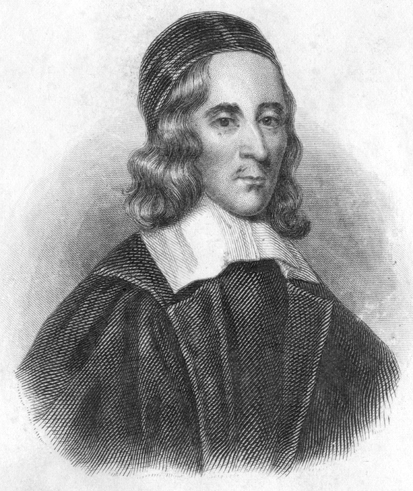When John Drury, himself an Anglican divine, told James Fenton (the son of a canon of Christ Church) that he was writing about George Herbert, Fenton replied with gnomic brio ‘The poet!’ adding ‘Both in intention and execution.’ Herbert’s authentic lightness and strength, pathos and wit, alertness and sympathy have long been as precious to poets as to fellow believers.
In Music at Midnight Drury has produced a pleasantly old-fashioned account of Herbert’s life and poetry which will serve as an introduction to new readers and remind devotees of many favourite passages, sometimes interestingly contextualised. He declares at the outset that ‘poetry comes from life’ and that ‘the biographical structure of this book maps out the ground which produced the poetry’. The book is lavishly illustrated and particularly sensitive to landscape and architecture.
Any biographer of Herbert has to contend with Walton’s Life, written in 1670 looking back across the chasm of the Civil War. Walton presents Herbert as a model of ‘primitive’ Anglicanism. Although he had access to contemporary sources, large parts of his narrative are clearly fashioned from reading Herbert’s work. It is probably best to consider him as an early (and partisan) reader. Drury dismisses his account of Herbert’s induction to the priesthood in the presence of Laud and Charles I as a farrago, but when he finds an aspect of Walton’s account congenial he is not above endorsing it as ‘so vividly actual as to suggest authenticity’. Indeed his book takes its — most affecting — title from another of Walton’s artful concoctions.
The documentary evidence for Herbert’s life is already well established and Drury has nothing to add to it. But he is adept at filling in the background: there are good sections on the influence of Lancelot Andrewes; Herbert’s formidable mother Magdalen, who in 1609 married the handsome Sir John Danvers, a man half her age; his friendships with Donne and Bacon; his work as public orator at Cambridge; his hesitant progress in the 1620s towards the priesthood, encouraged by the often underestimated John Williams, Bacon’s successor as Lord Keeper and Bishop of Lincoln; and Nicholas Ferrar and his household at Little Gidding, to whom we owe the existence of The Temple.
Drury rightly places great emphasis on the crisis that seems to have paralysed Herbert in the mid 1620s after the public oratorship at Cambridge had brought him to the notice of the court and put him in the way of worldly advancement. He senses that Herbert was more at home in the Jacobean church than its successor, and acutely analyses the way in which his pacifism at the time of Charles and Buckingham’s failed Spanish adventure might not have proved helpful. But he seems not to have considered whether James’s death in 1625 and the new king’s increasing reliance on Buckingham and Laud cast a catastrophic shadow across Herbert’s world view that may account for the modesty of his eventual choice of the vicarage at Bemerton.
Certainly Herbert’s known sponsors, such as John Davenant at Salisbury and John Williams at Lincoln, were equally out of sorts at the change. Years later Williams was found to have received letters from a colleague describing Laud as ‘the little meddling hocus-pocus’. Drury nods occasionally towards that robust Jacobean Protestantism — an intelligent amalgam of radical doctrine with formalist instincts — so richly researched by Patrick Collinson and subsequent historians.
But mostly he clings to a rather bland view of what he anachronistically calls ‘Jacobean Anglicanism’, to which Calvinism is as antipathetic as popery. It will be interesting to see how his forthcoming Penguin edition deals with Hebert’s poem ‘The Waterfall’ (not mentioned here) with its uncompromising recitation of double predestination.
The same reluctance to look hard or afresh dulls Drury’s dutiful treatment of Herbert’s poetry. He prints a large number of poems in full and suggests connections with episodes in Herbert’s life which are often suggestive, if unknowable, because Herbert’s perfect verbal touch makes dating from internal evidence unusually difficult. But his patient exegesis tends towards paraphrase, while his emphasis on Herbert’s prosody continually catalogues rhyme schemes and line lengths already evident to the eye and ear.
He tells us what ‘enjambment’ means (twice), that Latin is an inflected language, and that ‘suit’ means ‘plea’ and ‘not posh clothes’. His reading of ‘Redemption’, a poem as terse and vivid as one of Christ’s own parables, explains that it ‘combines secular and sacred: the legal action of cancelling … a liability, and the salvation of mankind by Christ’s sacrificial death.’ It misses the irony that the alienation of church lands by corrupt bishops (‘rich lords’) was a contemporary scandal: the Bishop of Llandaff quipped that his see should have been called ‘Aff’, ‘the land thereof being long since alienated’.
Drury’s favourite epithet for Herbert’s verse is ‘sprightly’. Concerning ‘Love (III)’ he observes ‘Love loves jokes’, laughably adducing in evidence a ‘pun’ in the creator’s reassurance to his self-doubting creation, ‘Who made the eyes but I?’






Comments